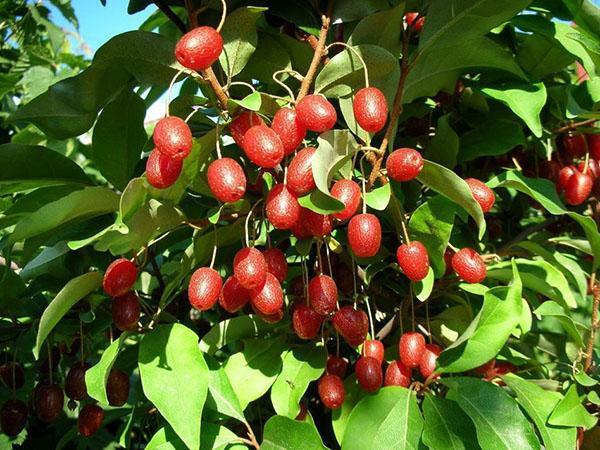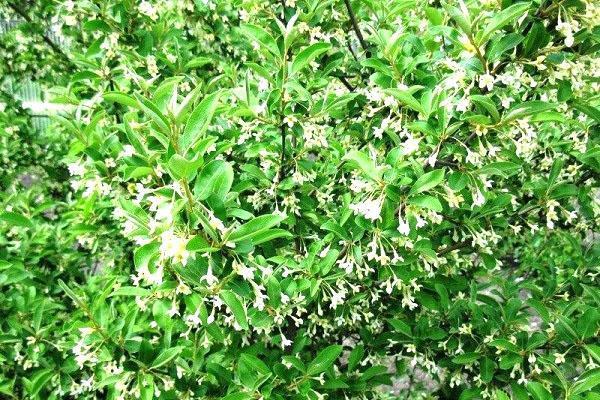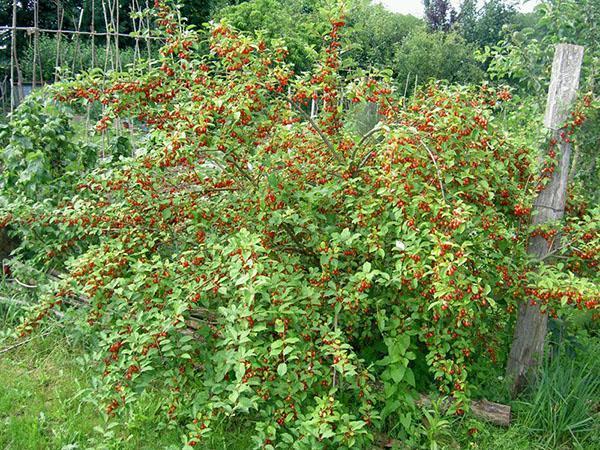We grow gumi fruit bush on our site
 China is considered the homeland of gumi, but the Japanese were the first to take up its active cultivation. They also brought him to the territory of the Far East. It was here, on Sakhalin, that Russian scientists started breeding this fruit shrub. Today culture is spread throughout Russia.
China is considered the homeland of gumi, but the Japanese were the first to take up its active cultivation. They also brought him to the territory of the Far East. It was here, on Sakhalin, that Russian scientists started breeding this fruit shrub. Today culture is spread throughout Russia.
Brief botanical description

The flowering of the multiflorous oak falls at the end of May. 1.5 months after pollination, the fruits of gumi ripen - small oval drupes. In the phase of biological ripeness, they have a red skin with light dots and are able to hold out on the bush until frost without shedding. The juicy and transparent pulp has a sour-sweet taste with a slight astringency.
 In the East, gumi berries have been used in folk medicine since ancient times. In Russia, they are usually dried or frozen and used for compotes in winter. They are also added to jam, sauces, jams.
In the East, gumi berries have been used in folk medicine since ancient times. In Russia, they are usually dried or frozen and used for compotes in winter. They are also added to jam, sauces, jams.
 Thus, the multifloral goose can perform several functions on the site:
Thus, the multifloral goose can perform several functions on the site:
- decorative;
- melliferous;
- economic.
In regions with mild winters, this shrub is able to exhibit the qualities of an evergreen plant, retaining its decorative effect throughout the year.
Nitrogen-fixing soil bacteria readily develop on the root system of the multifloral sucker. Therefore, planting this plant can serve to improve the soil on the site.
Growing conditions
 The gumi shrub is unpretentious and easily takes root in the Russian climate, but for its successful cultivation, suitable conditions are required:
The gumi shrub is unpretentious and easily takes root in the Russian climate, but for its successful cultivation, suitable conditions are required:
- Good sun exposure. The plant is able to tolerate shade, but a decent yield is observed only when planted in an open, sunny area.
- Light, but water-absorbing soil. The root system of the shrub branches widely in the upper layers of the soil. On heavy clays, it will become very waterlogged, and dry on sands. Therefore, fertile loams or sandy loams are preferred for planting.
- Cross-pollination. The flowers of the sucker are monoecious, and the culture is capable of self-pollination. But cross-pollination significantly increases yields, and it is advisable to plant 2-3 plants at the same time.
 Under good conditions, the berry yield is 8-9 kg per bush.
Under good conditions, the berry yield is 8-9 kg per bush.
Practice shows that the elk winters well in the middle lane. But gumi is a plant with low frost resistance, and in a harsh winter, its shoots can freeze slightly.  Therefore, gardeners of Siberia or the northern regions must provide protective shelters for their plantings.
Therefore, gardeners of Siberia or the northern regions must provide protective shelters for their plantings.
For better wintering, the shoots of the multifloral sucker can be bent to the ground, and the bush can be covered with two layers of spunbond with a density of 60 g / m2.
Gumi varieties: characteristics and photos
Gumi varieties began to be registered in the State Register of Breeding Achievements in 1999. To date, the list of plants approved for use on the territory of Russia includes 9 names:
- Sakhalin first. The berries of this early ripening variety are egg-shaped, red in color, and their average weight is 1.4 g.The taste of the fruit is pleasant, refreshing, with sourness, assessment during tasting - 4 points. It has excellent resistance to infections, almost not damaged by pests.

- Moneron. The value of the variety is increased frost resistance and stable yield. Ripening of berries occurs in medium terms. They have a mass of 1.5 g and a high sugar content in the pulp. Tasting score - 4 points. Disadvantages - average resistance to infections and insect pests.

- Thaisa. An early ripe dessert variety, with thorniness only on old shoots in the lower part, which makes plant maintenance and its bending for the winter easier. Increased resistance to frost, to infections and pests - at an average level. Small berries weigh on average 1.2 g, taste sour, delicate. Tasting score - 4.5 points.

- Crillon. Best suited for freezing. The gumi berry of this variety is bright red, thin-skinned, sweet with a pronounced but gentle astringency. Tasting score - 5 points. High winter hardiness, which makes it possible to recommend Krillon for cultivation in all Russian regions.

- Shikotan. An early ripe variety of multiflower sucker with large berries (on average - 2.1 g). The high percentage of sugar in fruits makes them sweet. During the tasting, the commission gave a high assessment of the taste of Shikotan fruits - 5 points. The winter hardiness of the gumi plant is good, but sometimes fungal infections are observed.

- Southern. A variety with large cylindrical berries (on average - 2.3 g each). The skin is red, tender, the fruits themselves are very juicy, sweet taste, with pleasant astringency, were evaluated at 5 points during tasting. A winter-hardy plant with an average yield. Medium resistance to fungi and pests.

- Kunashir. A late-ripening variety characterized by high quality fruit. The berries are thin-skinned, an average of 2.2 g each. The pulp is juicy, with a high percentage of sugar, tart. Tasting score - 5 points. The plant is vigorous, frost-resistant, with a decent immunity to infections and pests.

- Tsunai. A mid-season variety with strong spiny shoots. Forms a bush of medium height. The berries are medium-sized (1.9 g), with a dense skin. The taste of the pulp is sour, the juiciness is high, the tasting score is 5 points. Winter hardiness and immunity to fungi are at a high level, the plant is rarely damaged by pests.

- Paramushir. The youngest variety of gumi, introduced in 2016. A vigorous shrub with late ripening and berries weighing 1.8 g. The pulp is covered with a thin delicate skin, juicy, tart and sweet on the palate. Tasting score - 5 points. Paramushir's purpose is universal. Winter hardiness at a high level, which makes it possible to recommend the plant for all regions of Russia. Immunity to infections and pests is good.

When choosing a variety, you must take into account the characteristics of your site. If it is located in a region with frosty winters, winter hardiness should be the defining characteristic. For cultivation in mild, but rainy climates, the plant's resistance to fungal infections is more important.
Planting and leaving
 In central Russia and in colder regions, the gumi seedling takes root better during spring planting. In the south, it is better to postpone the acquisition and planting until autumn so that the hot sun does not dry out the young plant before it grows a good root system.
In central Russia and in colder regions, the gumi seedling takes root better during spring planting. In the south, it is better to postpone the acquisition and planting until autumn so that the hot sun does not dry out the young plant before it grows a good root system.
 Planting is carried out in a previously prepared planting pit. Its dimensions depend on the size of the seedling root system. The average depth is 0.5 m, diameter 0.8-1 m.Gumi planting step-by-step looks like this:
Planting is carried out in a previously prepared planting pit. Its dimensions depend on the size of the seedling root system. The average depth is 0.5 m, diameter 0.8-1 m.Gumi planting step-by-step looks like this:
- a drainage layer is laid on the bottom of the pit - expanded clay or crushed brick;
- in a separate container, a fertile mixture is prepared from garden soil, compost and coarse sand;
- 200 g is added to the soil mixture superphosphate and 600 g of wood ash per bush;
- part of the soil mixture is poured onto the bottom of the pit with a mound;
- the seedling is placed on the top of the mound so that the root collar is at the level of the soil;
- the roots of the gumi seedling are straightened along the slopes of the mound and covered with the rest of the soil mixture;
- abundant watering and mulching of the trunk circle is performed.
At first after planting, the seedling needs to be shaded from the bright sun and monitor soil moisture.
Seedlings with a closed root system are rolled into the planting pit along with an earthen clod.
 Further care for the gumi seedling consists in regular watering, weed removal and the prevention of fungal infections. Top dressing begins next year:
Further care for the gumi seedling consists in regular watering, weed removal and the prevention of fungal infections. Top dressing begins next year:
- spring feeding - 8 kg of compost, 30 g of double superphosphate and 150 g wood ash under the bush;
- summer feeding - watering with fermented herbal infusion once every 2 weeks;
- autumn feeding - 40 g of potassium magnesium per 1 m2 trunk circle.
 The successful cultivation of gumi also implies regular pruning of the bush. Dry and diseased shoots are removed from young plants in autumn, while frozen branches are shortened to healthy wood in spring. Starting from the 10th year of life, the bushes need anti-aging pruning. To do this, the oldest trunks are cut, the rest are cut to one third of the length.
The successful cultivation of gumi also implies regular pruning of the bush. Dry and diseased shoots are removed from young plants in autumn, while frozen branches are shortened to healthy wood in spring. Starting from the 10th year of life, the bushes need anti-aging pruning. To do this, the oldest trunks are cut, the rest are cut to one third of the length.
 The correct selection of the variety, adherence to the growing conditions and good care will ensure stable annual gumi fruiting and decent yields.
The correct selection of the variety, adherence to the growing conditions and good care will ensure stable annual gumi fruiting and decent yields.